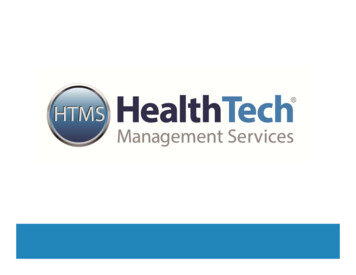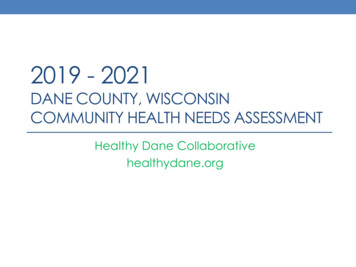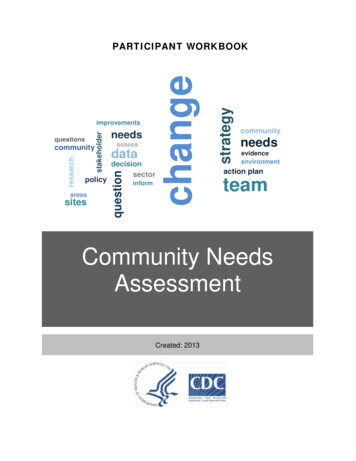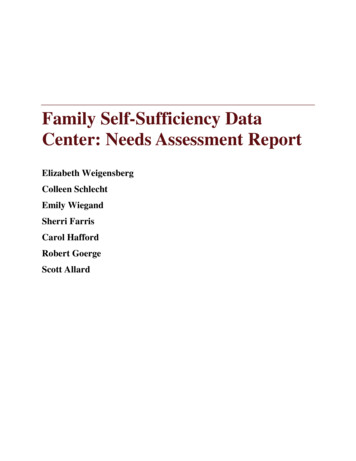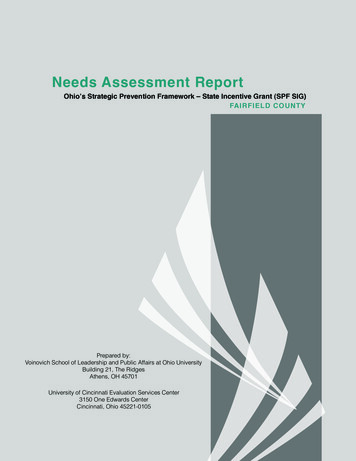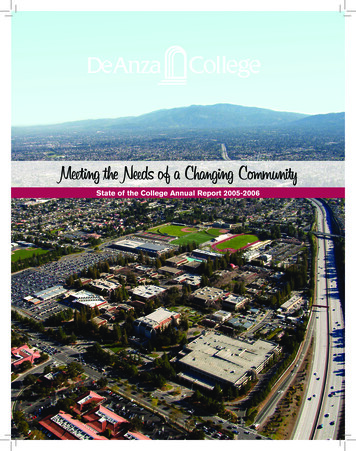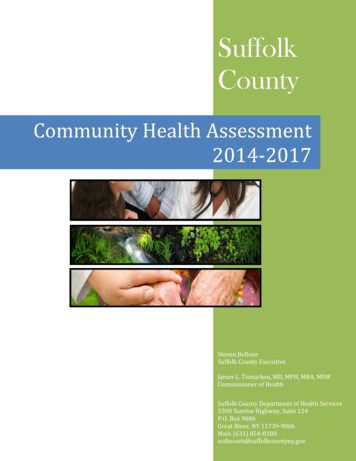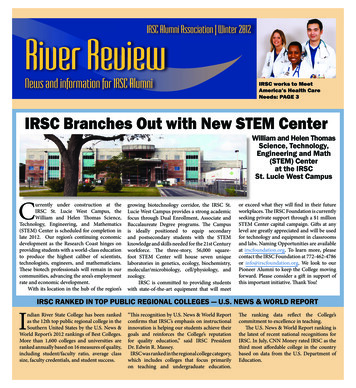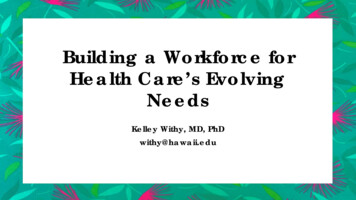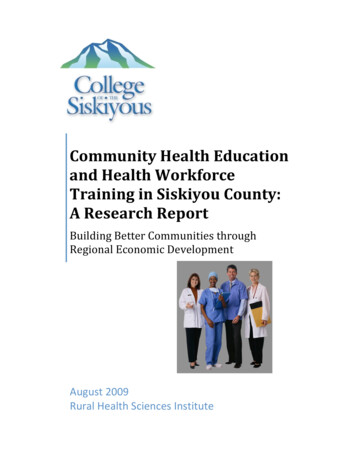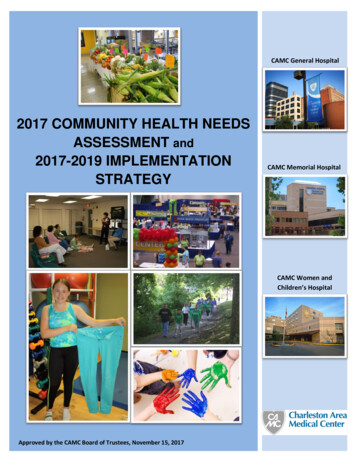
Transcription
CAMC General Hospital2017 COMMUNITY HEALTH NEEDSASSESSMENT and2017-2019 IMPLEMENTATIONSTRATEGYCAMC Memorial HospitalCAMC Women andChildren’s Hospital0Approved by the CAMC Board of Trustees, November 15, 2017
Charleston Area Medical CenterCAMC General Hospital, CAMC Memorial Hospital andCAMC Women and Children’s HospitalCharleston, West Virginia2017 Community Health Needs Assessmentand Implementation PlanTable of ContentsExecutive Summary. 3Community Health Needs Assessment . 4Kanawha Coalition for Community Health Improvement Community HealthNeeds Assessment Process and Findings .5CAMC Needs Assessment for Other Primary andSecondary Service Area Counties. 23Charleston Area Medical Center Community Needs Planning . 26Input Received on Prior Community Health Needs Assessment and ImplementationStrategy from the Public .292017 – 2019 CAMC Community Benefit Plan Implementation Strategy . 30CAMC Joint Implementation Strategies1. Accountable Health Communities Program . 302. Build the Base of Local Growers Providing Fresh Vegetables to CAMC . 323. Provide HIV Primary Care and Decrease New HIV Infections . 334. Examine How Brain Imaging Helps Doctors in Treatment of Dementia . 355. Build a Sustainable Research Infrastructure . 36CAMC General Hospital6. Provide Medical Direction to EMS Agencies . 38CAMC Memorial Hospital7. Prevent Drug Relapse and Decrease Incidence of Endocarditis . 39CAMC Women and Children’s Hospital8. Decrease the Number of Drug Affected Mothers and Babies . 409. Decrease the Number of Drug Affected Mothers and Babies Among IncarceratedWomen. 4110. Decrease the Number of Pregnant Women Using Tobacco Products. 411
11. Tobacco Cessation in the Pregnant Population and Their Households. 4212. Provide Mental Health Services to Children with Cancer . 4313. Determine How Dulaglutide Compares to Placebo in Children and Teens with Type2 Diabetes . 432
Charleston Area Medical CenterCAMC General Hospital, CAMC Memorial Hospital andCAMC Women and Children’s HospitalCharleston, West Virginia2017 Community Needs AssessmentExecutive SummaryThis Community Needs Assessment provides the basis for the community benefit programs thatCharleston Area Medical Center will address from 2017-2019 to improve the health of ourcommunity.Our programs and services go well beyond the traditional health care we often think of when weconsider hospital care and are delivered both inside and outside the walls of our hospitals. Theyare driven by our mission, Striving to provide the best health care to every patient, every day. Ourhospitals and outpatient programs and services bring our mission to life – providing effective,efficient, equitable, timely and safe care to all, regardless of ability to pay.Charleston Area Medical Center is a not-for-profit four-hospital system comprised of CAMCMemorial Hospital, CAMC General Hospital, CAMC Women and Children’s Hospital and CAMCTeays Valley Hospital. Our hospitals operate under one administrative structure and participate injoint strategic planning and budgeting processes. Each hospital has responsibility for key servicelines. Our hospitals are designed to provide care for our community residents throughout everystage of their lives. Our patients depend on us to provide convenient and compassionate care –care delivered regardless of a patient’s ability to pay. CAMC’s Kanawha County hospitals serveas resident teaching facilities for internal medicine, internal medicine/pediatrics, internalmedicine/psychiatry, family medicine, pediatrics, surgery, psychiatry, obstetrics and gynecology,emergency medicine, urological surgery, osteopathic internship, internal medicine geriatricfellowship, vascular surgery fellowship, oral and maxillofacial surgery fellowship and pharmacy.We provide our community with programs of excellence in cardiovascular services, medicine,surgery, oncology, trauma, neurology, orthopedics, rehabilitation, bariatrics, and women andchildren’s services. CAMC Teays Valley Hospital addresses community benefit for its PutnamCounty service area and completes its own community health needs assessment in conjunctionwith others in Putnam County. As a community hospital, CAMC Teays develops its ownimplementation strategies for its service area.CAMC General HospitalCAMC Memorial HospitalCAMC Women and Children’sHospital3
2017 COMMUNITY HEALTHNEEDS ASSESSMENT4
2017 COMMUNITY HEALTH NEEDS ASSESSMENTCharleston Area Medical Center conducted its seventh triennial community health needsassessment through the Kanawha Coalition for Community Health Improvement in the first quarterof 2017. Through our strategic planning process, the community health needs assessment is usedto set community health priorities for CAMC and for each of the CAMC hospitals in KanawhaCounty.CAMC Memorial Hospital, CAMC General Hospital and CAMC Women and Children’s Hospital areall located in Charleston, West Virginia (Kanawha County) and together make up Charleston AreaMedical Center. Although separately licensed, the hospitals all operate under one tax ID and oneprovider number. Each hospital specializes in services: CAMC Memorial (cardiology, vascular,oncology); CAMC General (neurosciences, orthopedics, trauma, medical rehabilitation); CAMCWomen and Children’s (women, children, NICU, PICU). General medicine and surgery are at bothCAMC Memorial and CAMC General Hospitals. The fourth CAMC hospital, CAMC Teays ValleyHospital is located in Putnam County, West Virginia and completes its own Community HealthNeeds Assessment and Implementation Strategies.The Kanawha Coalition for Community Health Improvement defines its community as KanawhaCounty. Because of the size and scope of our services, the approach we use at CAMC to identifyour community is based on our strategic objectives, key stakeholder needs, and our capacity. Forour CAMC community strategy, community is defined by the need identified and population to beaddressed. For example, some include a number of counties and others may be neighborhoodspecific.Detailed health and socioeconomic information for each of our service area counties is availableon the CAMC website (www.camc.org) in the document entitled Health Indicator Data Sheet.Primary and chronic disease needs and other health issues of uninsured, low-income persons, andminority groups are considered through all steps of the survey process.Kanawha Coalition for Community Health Improvement CommunityHealth Needs Assessment Process and FindingsThe Community Health Needs Assessment is conducted through the Kanawha Coalition forCommunity Health Improvement which was founded in 1994 by Kanawha County hospitalsworking in partnership with other local organizations. The Coalition's mission is to identify andevaluate health risks and coordinate resources to measurably improve the health of thepeople of Kanawha County. Since the last needs assessment, the Kanawha Coalition forCommunity Health Improvement was selected to participate as a Population Health FrameworkField Test Group by the National Quality Forum and as a Community Health ImprovementLearning Collaborative member by the CDC in recognition of its long term success in needsassessment process and improvement of community health.Steering Committee Members include:John Ballengee, President, United Way of Central West VirginiaMichael Brumage, M.D., Executive Director and Health Officer, Kanawha-Charleston HealthDepartmentMartha Cook Carter, CEO, FamilyCare Health CenterAlaina Crislip, Corporate Compliance Officer, Thomas Health System, Inc.David Ferretti, Partner, Spilman Thomas & Battle, PLLC5
Chris Ferro, Vice-President of Economic Development, Charleston Area AllianceBrenda Grant, Chief Strategy Officer, Charleston Area Medical CenterRahul Gupta, Health Commissioner, WV Bureau for Public HealthBrenda Isaac, Lead School Nurse, Kanawha County SchoolsDan Lauffer, CEO, Thomas Health System, Inc.Reverend James Patterson, Director, Partnership of African American ChurchesCynthia Persily, Administrator, Highland HospitalJessica Wright, Director, Division of Health Promotion and Chronic Disease, WV Bureau for PublicHealthJudy Crabtree, Executive Director, Kanawha Coalition for Community Health ImprovementThe Kanawha Coalition for Community Health Improvement’s goals for the Community HealthNeeds Assessment process include:1. Assess the health needs of the citizens of Kanawha County.2. Inventory available resources.3. Determine unmet needs.4. Evaluate and prioritize needs.5. Involve affected organizations and constituencies in developing possible solutions.6. Develop consensus.7. Facilitate implementation.8. Measure and evaluate outcomes.The Coalition's 2017 Community Needs Assessment covers a wide variety of health care topicsand was designed to determine perception of health care needs and health-related behaviors. Thesurvey also addresses a number of social and economic concerns.The assessment process encompasses the following: The collection, compilation and analysis of existing secondary county health data. Key informant interviews to gain input from professionals representative of key sectors ofthe community. A randomized household telephone survey to gain community input. Focus groups among residents of rural communities in Kanawha County. A health issues forum to set priorities for the Coalition’s work.6
OBJECTIVE DATA – SECONDARY COUNTY HEALTH DATAA comprehensive database of health related data and statistics is compiled/updated by CAMC stafffrom numerous sources regarding the health of the citizens of Kanawha County and isincorporated into the document entitled Health Indicator Data Sheet. The findings are sorted intocategories for ease of reference and provide the following for each indicator: name, data link,County results, West Virginia results, United States results, West Virginia county rank and UnitedStates state rank. The trend is then established for each indicator, as well as comparison to WestVirginia and the nation. These trends and comparisons are color coded to identify improvement intrend, and if comparisons are favorable or unfavorable. The Health Indicator Data Sheet isavailable on the CAMC and Kanawha Coalition websites and is used extensively by the communityfor community need, statistical and grant writing purposes.Members of the Kanawha Coalition Steering Committee actively participate in the survey planningprocess to provide public health insight and ensure data integrity. Additionally, epidemiologistsfrom the West Virginia Department of Health and Human Services work with the Coalition forquestion design for consistency with other surveys to allow benchmarks and comparisons. Inaddition, Key Informant Interviews provide in-depth information on the community.The processes for obtaining input from persons who represent the community follows and includedescriptions for the Household Telephone Survey, Focus Groups and Key Informant Interviews.HOUSEHOLD TELEPHONE SURVEYThe following summarizes the data derived from the randomized household telephone surveycompleted by 291 households from February 13 through March 9, 2017.Method:The household surveys were conducted using appropriate quality controls which included involvingresearch experts in the design of the survey instrument, thorough and consistent training ofinterviewers, and the use of reputable survey-analysis software. The principal investigator providedoversight to the survey process including data collection and entry. Data was collected andentered using a web-based survey. The report was compiled and verified for accuracy by membersof the Kanawha Coalition for Community Health Improvement. The survey sample size results in astatistically significant 95% confidence interval with an error of margin of plus or minus 5.73%. Notall respondents answered every question; therefore the margin of error was adjusted and reportedfor each question based on the number of respondents. Numbers too small to be statisticallysignificant are noted as such.An independent sampling company randomly selected landline telephone numbers for KanawhaCounty households. The random landline sample consisted of 8,600 numbers which was screenedfor disconnects and businesses, resulting in a list of 4,568 numbers. A total of twenty-six nursingstudents from The University of Charleston received training and administered the phone survey.Early release of estimates from the National Health Interview Survey, January – June 2015,National Center for Health Statistics, December 2015 (http://www.cdc.gov/nchs/nhis.htm), indicatethat the number of American homes with only wireless telephones continues to grow. Nearly onehalf of American homes (47.4%) had only wireless telephones during the first half of 2015 — anincrease of 3.4 percentage points since the first half of 2014. More than two-thirds of all adultsaged 25-34 and of adults renting their homes were living in wireless-only households. Furthermore,the report indicated that adults living in poverty (59.3%) and near poverty (54.4%) were more likelythan higher income adults (45.7%) to be living in households with only wireless telephones. Basedon this information, the Kanawha Coalition attempted to increase the number of responses amongyounger residents and lower income residents by doubling its acquired address-based sample of7
households with only wireless telephones. This randomly selected sample of 5,600 householdsreceived postcards in the mail directing them to the online survey or to call the Kanawha Coalitionto arrange a convenient time to take the survey by telephone.As with any telephone survey, there are certain limitations. The results of the survey depend onthe accuracy of the responses given by the persons interviewed. Self-reported behavior must beinterpreted with caution. To assure proper sampling distribution, the demographics of the surveyrespondents were compared to county demographics based on the U.S. Census QuickFacts fiveyear estimates 2010-2015. This comparison reveals an over-representation of respondents whowere female, over age 55, widowed, those without children in the home and Caucasian. There wasan under-representation of African Americans, people with lower-educational attainment (highschool or less), households with children in the home, and those who had never been married.FOCUS GROUPSTo understand community needs, focus groups were held throughout Kanawha County inNovember 2016. As one component of the Coalition’s five-part assessment, focus groups offerinsight into the needs, concerns and experiences of people whose voice is not often heard.Typically, focus groups are comprised of a small group of individuals, usually a vulnerable or targetpopulation. In this case focus groups were organized in communities located in differentgeographical locations in the county. It is important to note that the results reflect the perceptionsof some community members, but may not necessarily represent all community members inKanawha County.Method:A series of six focus groups were convened. Participants received an incentive for their completionof the focus group. The purpose of the discussion was to obtain input on issues that could impactthe health of the residents of their communities. A total of 51 community members participated infocus groups in the following communities: Cross LanesElkviewKanawha City MarmetMiamiLondonThe Kanawha Coalition for Community Health Improvement provided training to fourth yearnursing students from the University of Charleston - School of Health Sciences to enable them tofacilitate the groups. The students also compiled the results and prepared reports of the findingsfor the Kanawha Coalition.Report of Findings:Participants were provided with a map of a sample community along with a table that outlined thevarious social determinants of health (see below). The group facilitator asked participants toimagine walking through their own communities and to consider the various determinants. Topicsdiscussed included economic stability, physical environment, education, food, social support andthe health care system.8
Key Informants by Sector9
KEY INFORMANT INTERVIEWSThe following summarizes the qualitative data derived from the key informant surveys conductedwith 87 key informants in Kanawha County during April 2016.Method: Key informants were identified by the Kanawha Coalition’s Steering Committee. Ofthose identified, 87 completed the online survey. The survey included both standardized questionsand open ended questions, to elicit a full range of responses.Reporting of Findings: Key informants were asked to identify what they believe are the top threepopulations in Kanawha County with unmet needs. They also were asked to share what theythought were the biggest concerns in Kanawha County regarding health risk behaviors, clinicalcare, social and economic factors and the physical environment. They were asked to share whatchallenges and barriers they believe exist, along with their thoughts on what needs to happen toovercome these challenges and barriers. Finally, key informants were asked what they thoughtwere the “top three” issues overall in Kanawha County and to name what they believed to be thetop three health-related “assets and strengths” for the county.KEY INFORMANTSPamela L. AldermanAlex AlstonJennifer BaileyJohn BallengeeUniversity of CharlestonRoark Sullivan Life CenterKanawha County Circuit Court / Kanawha County Adult Drug CourtUnited Way of Central West VirginiaVicki BallengeeCommunity Development Outreach MinistriesMarie BeaverRea of Hope, Inc.Darick BiondiMount Juliet United Methodist ChurchElliott BirckheadWV DHHR-BBHHFGary BledsoeTown of ClendeninMichele BowlesRegional Family Resource NetworkMichael Brumage, MDKanawha Charleston Health DepartmentSteve BurtonFirst ChoiceDick CallawayCity of St. AlbansSamuel Carroll, MDVeterans AdministrationMartha CarterFamilyCare Health CentersMary CaldwellValley Health WIC ProgramKelli CasemanWest Virginia School Based Health AssemblyKristin ChandlerBehavioral Health, Charleston Area Medical CenterMark ChandlerTriana EnergyChristine ComptonAmerican Heart AssociationPatty DeutschPSIMED / Private PracticeStephanie DeWeesKanawha Charleston Health DepartmentSteve DexterThomas Health SystemDr. Michelle R. EastonUniversity of Charleston School of PharmacyLoren FarmerBob Burdette Center, Inc.10
Karmin FordAlzheimer's AssociationDan Foster, MDCharleston Area Medical CenterDr. Michelle FosterThe Greater Kanawha Valley FoundationLynne FruthFruth PharmacyJustin GaullCharleston Area AllianceEd GaunchWV State SenateBradley Henry, MDDrs. Henry, Kinder and AssociatesSteve HewittUnited Way of Central WVPaige HillBig Brothers Big SistersDavid HodgesCharleston Fire Dept.Brenda C. IsaacKanawha Charleston Health DepartmentJamie Jeffrey, MDKEYS4HealthyKids; HealthyKids Clinic at CAMCKim JohnsonKanawha County Emergency Ambulance AuthorityMichael JonesThe Kanawha Institute for Social Research & ActionKristi JusticeKanawha Communities That CarePaulette JusticeKanawha Valley Senior Services, Inc.S
Charleston Area Medical Center is a not-for-profit four-hospital system comprised of CAMC Memorial Hospital, CAMC General Hospital, CAMC Women and Children’s Hospital and CAMC Teays Valley Hospital. Our hospitals operate under one administrative structure and participate in joint strategic planning and budgeting processes.
